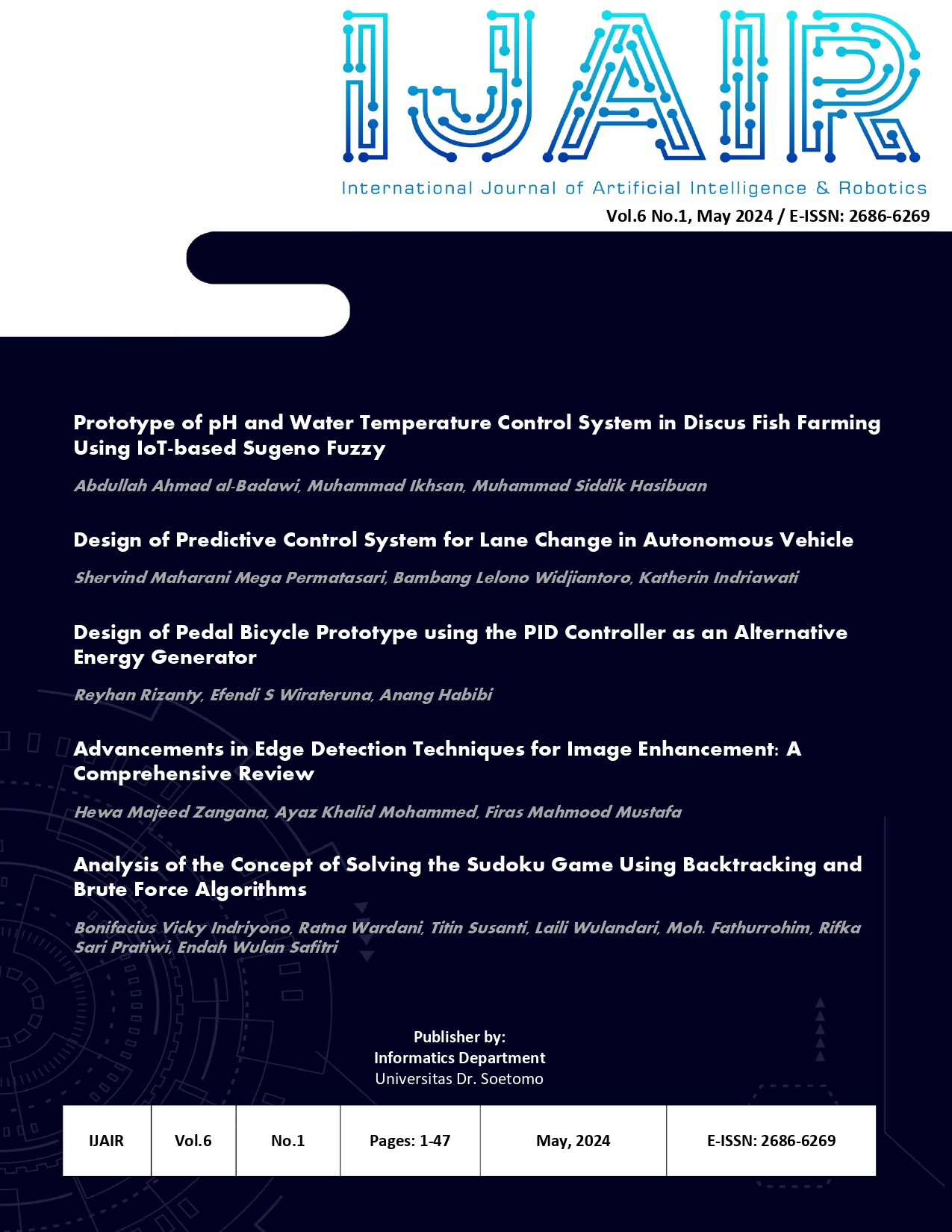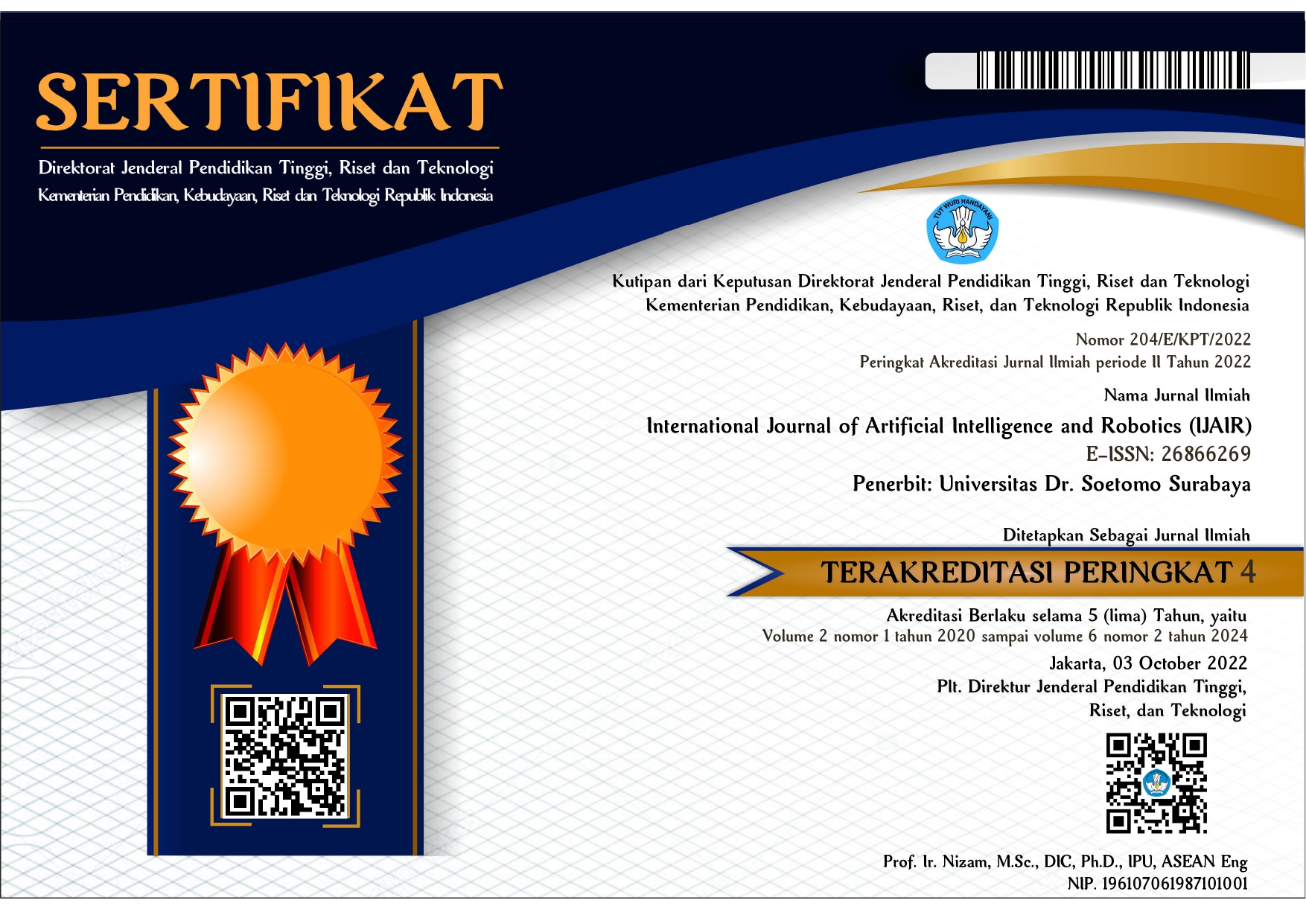Analysis of the Concept of Solving the Sudoku Game Using Backtracking and Brute Force Algorithms
 Abstract views: 489
,
Abstract views: 489
,
 PDF downloads: 350
PDF downloads: 350
Abstract
Sudoku is a puzzle game that arranges numbers from one to nine on a board consisting of 9x9 squares. This game has a rule: the numbers arranged on a board cannot be the same in each row or column. The main goal of this Sudoku game is to complete the board and win by entering numbers into each empty box. Therefore, in this Sudoku game, there is only one valid solution. At the start of the game, several numbers are provided, which serve as clues for players to fill in the next box. The number of clues at the start of the game determines whether the Sudoku game level is difficult. The fewer the clues given, the more difficult it is to solve Sudoku. Solving Sudoku problems cannot be done manually, so several algorithms are needed, which require a lot of repetition and search functions. In this research, we will compare concepts in solving Sudoku using the Backtracking algorithm and the backtracking algorithm using the brute force technique. This comparison is seen from the effectiveness of solving Sudoku. The results of this research conclude that to solve Sudoku logic quickly and efficiently, the backtracking algorithm can be used compared to the Brute Force algorithm. This is because the backtracking algorithm has better complexity, and the solution steps are fast and “smartâ€. In contrast, the brute algorithm takes longer to complete because the brute force algorithm has to search for all the possibilities. The average time required to complete 10 9 x 9 puzzle tests with backtracking is 10910.96 ms, while the brute force algorithm takes longer, around 15871.90 ms.
Downloads
References
S. Sauri, et al, "Pembuatan Media Pembelajaran Sudoku Puzzles Pada Materi Sistem Periodik Unsur", Gunung Djati Conference Series, Volume 2, Seminar Nasional Tadris Kimiya 2020, ISSN: 2774-6585, 2021.
A.A. Hanafi, et al, “Penyelesaian Permainan Sudoku Menggunakan Algoritma Backtracking Berbasis Artificial Intelligenceâ€, Jurnal ICTEE, Vol. 2, No. 2, E-ISSN : 2746-7481, pp. 50-57, 2021.
A. Sinaga; Nuraisana, “Implementasi Algoritma Brute Force Dalam Pencarian Menu Pada Aplikasi Pemesanan Coffee (Studi Kasus : Tanamera Coffee)â€, JIKOMSI [Jurnal Ilmu Komputer dan Sistem Informasi], Vol.4 No.1, pp 6-15, 2021.
F.A. Rahman; D. Anubhakti, “Implementasi Algoritma Backtracking Pada Permainan Sudokuâ€, MEANS (Media Informasi Analisa dan Sistem), Vol. 5, No.1, pp. 67-71, 2020.
C. Danuputri; N. Santosa, “Aplikasi Pemecahan Soal Sudoku dengan Metode Backtracking†, Jurnal Informatika Universitas Pamulang, Vol. 6, No. 3, pp. 506-511, 2021.
B.V. Indriyono, et al, “Comparative Analysis of the Performance Testing Results of the Backtracking and Genetics Algorithm in Solving Sudoku Gamesâ€, International Journal of Artificial Intelligence & Robotics (IJAIR), Vol.5, No.1, pp.29-35, 2023.
A. Yusuf; Hendra, “Penyelesaian Puzzle Sudoku Menggunakan Algoritma Brute Force Dan Backtrackingâ€, Jurnal Techno Nusa Mandiri, Vol.X, No.1, pp. 207-215, 2013.
Herimanto et al, “An Implementation of Backtracking Algorithm for Solving A Sudoku-Puzzle Based on Androidâ€, Journal of Physics: Conference Series, pp. 1-6, 2019. https://doi.org/10.1088/1742-6596/1566/1/012038.
F. Utama, et al , “Implementasi Backtracking Algorithm Untuk Penyelesaian Permainan Su Doku Pola 9x9â€, Informatika Mulawarman : Jurnal Ilmiah Ilmu Komputer, Vol. 11, No. 1,pp. 29–36. 2017. https://doi.org/10.30872/jim.v11i1.200,
Afriyudi et al, “Penyelesaian Puzzle Sudoku menggunakan Algoritma Genetikâ€, Prosiding SNASTI, ISBN 978-979-89683-31-0.
D.S. Rahayu, et al, "Evaluasi Algoritma Runut Balik dan Simulated Annealing pada Permainan Sudoku", Jurnal Teknik Informatika dan Sistem Informasi, Vol. 3, No. 1, pp. 170-178, 2017.
Yulyanto, et al, "Pengembangan Game Puzzle Find GrassMenggunakan Algoritma Backtracking", Bulletin of Information Technology (BIT), Vol 4, No 2, pp. 275-280, 2023..
H.S. Sulun; R. Muni, “Pembangkit Teka-Teki Silang Dengan Algoritma Backtracking Serta Aplikasi Permainannya Yang Berbasis Webâ€, Jurnal Informatika, Vol.4 No.2, pp. 457-466, 2010.
B.W. Santoso, et al, “Implementasi Algoritma Brute Force Sebagai Mesin Pencari (Search Berbasis Web Pada Databaseâ€, Jurnal Sisfotek Global, Vol. 6 No. 1, pp. 1-8, 2016.
A.T. Ramadhoni, et al, “Penerapan Algoritma Brute Force Pada Aplikasi Sidayko Berbasis Androidâ€, Jurnal MNEMONIC, Vol 5, No. 1, pp. 1-8, 2020.
M.E. Riadi, “Penggunaan Media Puzzle Untuk Meningkatkan Hasil Belajar Siswa Pada Tema Lingkungan Kelas Ii Sdn Jajartunggal Iii Surabayaâ€, JPGSD, Vol. 02, No. 02, pp. 1-11, 2014.
N. Nari et al, “Penerapan Permainan Puzzle Untuk Meningkatkan Kemampuan Membilangâ€, Jurnal Pembangunan dan Pendidikan: Fondasi dan Aplikasi, Vol.7, No. 1, pp. 44-52, 2019.
A.T. Benjamin, “The Mathematics of Games and Puzzles: From Cards to Sudokuâ€. Amerika: Harvey Mudd College; 2013.
R.D.I Sari, “Analisis Penyelesaian Puzzle Sudoku dengan Menerapkan Algoritma Backtrackingâ€. Jurnal Ilmiah Teknologi dan Informasi Asia.Vol. 2, No. 2, pp. 1-18, 2011.
Copyright (c) 2024 Bonifacius Vicky Indriyono, Ratna Wardani, Titin Susanti, Laili Wulandari, Moh. Fathurrohim, Rifka Sari Pratiwi, Endah Wulan Safitri

This work is licensed under a Creative Commons Attribution-ShareAlike 4.0 International License.
Authors who publish with International Journal of Artificial Intelligence & Robotics (IJAIR) agree to the following terms:
-
Authors retain copyright and grant the journal right of first publication with the work simultaneously licensed under a Creative Commons Attribution License (CC BY-SA 4.0) that allows others to share the work with an acknowledgment of the work's authorship and initial publication in this journal.
-
Authors are able to enter into separate, additional contractual arrangements for the non-exclusive distribution of the journal's published version of the work (e.g., post it to an institutional repository or publish it in a book), with an acknowledgment of its initial publication in this journal.
-
Authors are permitted and encouraged to post their work online (e.g., in institutional repositories or on their website) prior to and during the submission process, as it can lead to productive exchanges, as well as earlier and greater citation of published work.















